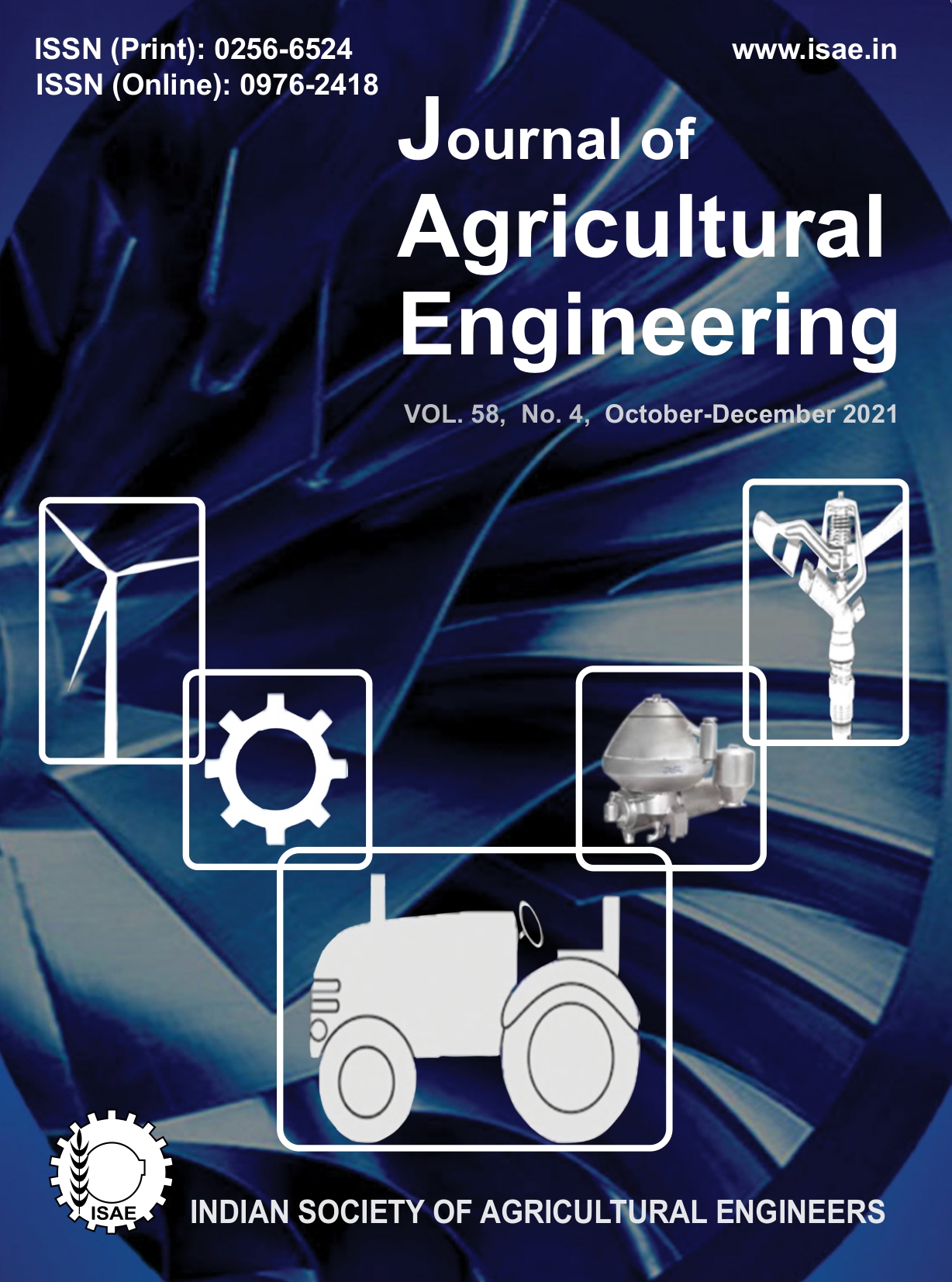Evaluation of Farm Ponds of Kharagpur Blocks of West Bengal, India
DOI:
https://doi.org/10.52151/jae2021581.1759Keywords:
Farm pond, pisciculture, Bentonite lining, water balance, water quality, socio-economicsAbstract
Marginal and small farmers of the state of West Bengal suffer from frequent droughts due to erratic rainfall patterns, high evaporation rates, and recurrent water scarcity. The majority of farmers in West Bengal have farm ponds that are grossly underutilized due to several social and technical constraints. In this study, the roles of various socio-economic factors on management of existing farm ponds were examined using a binary logit model to understand their contributions to sustainability of the livelihoods of marginal and small farmers of the region. A field survey of 155 farm ponds, owned by farmers with different socio-economic backgrounds, was undertaken in Kharagpur Blocks (I, II) of West Medinipur district in West Bengal. The study also included water budget, water quality, and economic analyses of three farm ponds having different management practices, viz. managed bentonite lined pond, managed unlined pond, and unmanaged unlined pond. Water budget analysis revealed that about 610 mm of extra water depth could be saved in bentonite-lined ponds compared to unlined ponds. Also, the water quality (as per the threshold values recommended for aquaculture life) was not deteriorated due to bentonite lining. The study suggested that the best way of utilizing pond water includes simultaneous water use for irrigation and fish cultivation, which is possible with lined ponds. Therefore, lined farm ponds with locally available cheap lining material might be a suitable intervention in the context of the socioeconomic development of small and marginal farmers of the Kharagpur region. The pond management was significantly influenced by household economic factors and pond related factors.
References
AAR. 2012. Annual Administrative Report for 2011-12, Finance Department, West Medinipur, Government of West Bengal, 5-6.
Bapari Y; Joy A K. 2017. Estimation of rice production function in Rajbari district, Bangladesh: An econometric analysis. Asian J. Hum. Art Lit., 4 (2), 117-130.
Bashar M Z I; Karim M R; Imteaz M A. 2018. Reliability and economic analysis of urban rainwater harvesting: A comparative study within six major cities of Bangladesh. Resour. Cons. Recy., 133, 146-154.
Biswas S; Sahoo S; Debsarkar A; Pal M. 2021. Assessment of adoption potential of rooftop rainwater harvesting to combat water scarcity: A case study of North 24 Parganas district of West Bengal, India. Arab. J. Geosci., 14(16), 1-6.
Chaarlas L J; Velmurugan J M. 2012. Mahatma Gandhi National Rural Employment Guarantee Act, 2005 (MGNREGA): Issues and Challenges. Int. J. Phys. Soc. Sci., 2, 253-261.
CWC. 2013. Water and Related Statistics. Water Resources Information System Directorate, Central Water Commission, Govt. of India, pp. 212.
Deepika S; Rao B K. 2018. Farm ponds lining materials: A review article. Int. J. Curr. Microbial. App. Sci., 7(11), 516-525.
Gujarati D N; Porter D C; Gunasekar S. 2012. Basic Econometrics. 5th edition, Tata McGraw-Hill Education Pvt. Ltd., New Delhi, pp: 886.
IBM Corp. 2012. IBM SPSS Statistics for Windows, Version 21.0. Armonk, NY: IBM Corp.
Machiwal D; Jha M K. 2016. Exploring hydrogeology and groundwater dynamics in a lateritic terrain of West Bengal, India, under limited data conditions. Environ. Earth Sci., 75, 1-19.
Nag A; Gupta H. 2014. Physicochemical analysis of some water ponds in and around Santiniketan, West Bengal, India. Int. J. Environ. Sci., 4, 676-682.
Osman M; Sreenivaslu R; Prasad L K; Rao K V; Panda A R; Haffis S. 2013. Economic evaluation of lined farm pond for supplemental irrigation to FCV tobacco in Southern Andhra Pradesh. Indian J. Dryland Agric. Res. Dev., 28(1), 38-42.
Panigrahi B; Panda S N; Mal B C. 2007. Rainwater conservation and recycling by optimal size on-farm reservoir. Resour. Conserv. Recycle, 50, 459-474.
Rao Ch S; Rejani R; Rao C A R; Rao V; Osman M; Reddy K S; Kumar M; Kumar P. 2017. Farm ponds for climate-resilient rainfed agriculture. Current Sci., 112(3), 471-477.
Sasaqi D; Pranoto; Setyono P. 2019. Estimation of water losses through evapotranspiration of water hyacinth (Eichhornia crassipes). Caraka Tani J. Sustain. Agric., 34(1), 86-100.
Shekhar S; Mailapalli D R; Raghuwanshi N S. 2021. Simulating nitrogen transport in paddy crop irrigated with alternate wetting and drying practice. Paddy Water Environ., 19, 499-513.
Shikur A; Beshah T. 2013. Analysis of influencing factors in adoption of rainwater harvesting technology to combat the ever changing climate variability in Lanfuro Woreda, Southern region, Ethiopia. J. Agric. Res., 2 (1), 15-27.
Singh P K; Rathore L S; Rao D B; Singh K K; Baxla A K; Bhan S C; Gupta A; Singh S. 2017. Spatial analysis of rainfall variability and rainfed rice crop using GIS Technique in West Bengal (India). Mausam, 68(2), 287-298.
Subudhi C R; Senapati S C. 2014. Water harvesting through farm pond and utilization of conserved water for vegetable crops. J. Biol. Chem. Res., 13(1),1-7.














